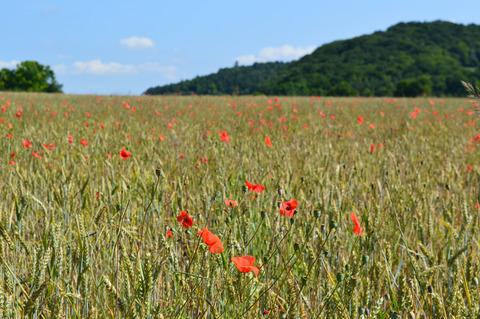当前位置:
X-MOL 学术
›
J. Appl. Ecol.
›
论文详情
Our official English website, www.x-mol.net, welcomes your feedback! (Note: you will need to create a separate account there.)
Agri‐environment schemes enhance pollinator richness and abundance but bumblebee reproduction depends on field size
Journal of Applied Ecology ( IF 5.7 ) Pub Date : 2020-06-29 , DOI: 10.1111/1365-2664.13682 Costanza Geppert 1, 2 , Annika Hass 1, 3 , Rita Földesi 4 , Bettina Donkó 1 , Asma Akter 5 , Teja Tscharntke 1 , Péter Batáry 1, 6
中文翻译:

农业环境计划提高了传粉者的丰富度和丰度,但大黄蜂的繁殖取决于田间大小
更新日期:2020-06-29
Journal of Applied Ecology ( IF 5.7 ) Pub Date : 2020-06-29 , DOI: 10.1111/1365-2664.13682 Costanza Geppert 1, 2 , Annika Hass 1, 3 , Rita Földesi 4 , Bettina Donkó 1 , Asma Akter 5 , Teja Tscharntke 1 , Péter Batáry 1, 6
Affiliation

|
- Pollinators have experienced a dramatic decrease world‐wide due to agricultural intensification. In many countries, agri‐environment schemes (AES) have been introduced to counteract this current trend. However, until now, the relative importance of each AES for biodiversity and ecosystem services is still little understood and might change depending on landscape context. Complex landscape‐experiments are required to fill this knowledge gap, enabling the implementation of sustainable intensification of food production.
- In our study, we compared the effectiveness of the two most popular AES in Germany, organic farming and flower strips, in supporting pollinators and flower resources. We selected nine landscapes along a gradient of increasing field size, (configurational heterogeneity), each with a triplet of winter wheat fields: one organic, one conventional with flower strip and one conventional without flower strip as a control. We surveyed insect‐pollinated plants and pollinators (bumblebees, solitary bees and hoverflies). Additionally, we placed bumblebee colonies in the field edges to monitor their growth (colony weight gain) and reproduction (queen production).
- Flower strips stood out with the highest abundance and richness of pollinators. In contrast, bumblebee colony growth and plant richness benefited equally from organic and flower strip schemes. At the landscape scale, smaller fields had a positive effect on plant richness and bumblebee reproduction in flower strips. By contrast, bumblebee colonies in organic agriculture benefited most from large fields, as large organic fields provided much more flower resources than the narrow flower strips.
- Synthesis and applications. Our results showed that both local and landscape management shaped pollinator communities and their reproduction. Overall, organic farming and flower strips appeared to be effective tools to mitigate flower shortage in conventional cereal fields, with organic farming supporting the highest flowering plant cover per field. Flower strips enhanced local pollinator richness most, but increased bumblebee reproduction only when the surrounding landscapes had small fields with long field borders. Therefore, our results reveal that European Union policies need to take into account that the effectiveness of agri‐environment schemes depends on the structure of the surrounding landscape.
中文翻译:

农业环境计划提高了传粉者的丰富度和丰度,但大黄蜂的繁殖取决于田间大小
- 由于农业集约化,授粉媒介在世界范围内经历了急剧减少。在许多国家,已经采用了农业环境计划(AES)来抵消这种当前趋势。但是,直到现在,每个AES对生物多样性和生态系统服务的相对重要性仍然鲜为人知,并且可能会根据景观环境而变化。需要进行复杂的景观试验来填补这一知识空白,从而能够实现粮食生产的可持续集约化。
- 在我们的研究中,我们比较了德国两种最流行的AES(有机农业和花卉条)在支持传粉媒介和花卉资源方面的有效性。我们选择了沿着逐渐增大的田地大小(构型异质性)的9个景观,每个景观都有三联体的冬小麦田:一种是有机的,一种是常规的带花条,另一种是常规的不带花条作为对照。我们调查了昆虫授粉的植物和传粉媒介(大黄蜂,孤蜂和蚜虫)。此外,我们将大黄蜂菌落放在田间边缘,以监测它们的生长(菌落增重)和繁殖(产卵量)。
- 花带以传粉者的丰度和丰富度最高而脱颖而出。相比之下,大黄蜂的菌落生长和植物丰富度同样受益于有机和花卉剥离方案。在景观尺度上,较小的田地对花条中的植物丰富度和大黄蜂繁殖产生积极影响。相比之下,有机农业中的大黄蜂菌落从大田中受益最多,因为大有机田提供的花卉资源比窄条状的花条多得多。
- 综合与应用。我们的结果表明,当地和景观管理都对传粉媒介群落及其繁殖产生了影响。总体而言,有机农业和花卉条似乎是减轻常规谷物田花卉短缺的有效工具,有机农业为每个田地提供最高的开花植物覆盖率。花条可以最大程度地提高当地传粉媒介的丰富度,但仅当周围的景观具有小田野和长田野边界时,大黄蜂才能繁殖。因此,我们的结果表明,欧盟政策需要考虑到农业环境计划的有效性取决于周围景观的结构。



























 京公网安备 11010802027423号
京公网安备 11010802027423号